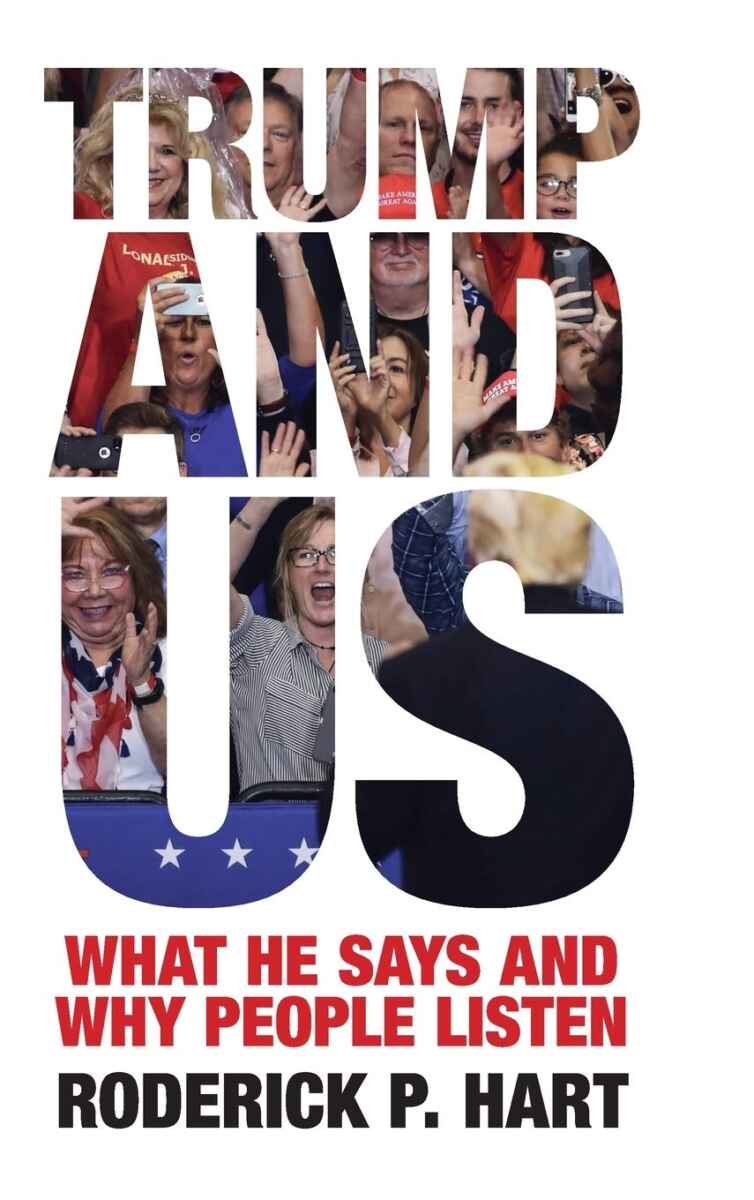
The book TRUMP AND US. What he says and why people listen (Amazon.com, Amazon.de, Amazon.fr) by Roderick P. Hart is one of many trying to explain the phenomen Donald Trump. The professor at the University of Texas at Austin examines Trump’s words, voters’ remarks and media commentary seriously. His books offers a systematic rhetorical analysis of Trump’s 2016 campaign and early presidency, using text analysis, archives of earlier presidential campaigns to uncover deep emotional undercurrents in the United States and provide historical comparison. Roderick P. Hart argues that it was not partisanship, policy or economic factors that landed Trump in the White House but rather how he made people feel.
Each chapter of Trump And Us. What he says and why people listen offers a short conclusion which allows quick reading, finding easily what you are most interested in. Roderick P. Hart is seeking a broader, cultural understanding of the American polity and of those who support the Trump presidency. The author examined campaign speeches, press conferences, media interviews, letters to the editor, open-ended polls, political news coverage, peron-on-the-street interviews, Trump’s tweets and citizens’ reactions to social media.
Throughout the book, Roderick P. Hart offers alternative explanations for the Trump phenomenon by taking political language seriously, placing special faith in word patterns that go unnoticed by the casual observer as well as by seasoned White House reporters. Crass though he can be, Trump’s language shows a surprising cultural awareness. According to the author, we need to learn what his gut tells him.
Roderick P. Hart explores four primary emotions that drove many voter into the Trump camp, emotions that continued to hold sway four years later: many US Americans felt ignored so he acknowledged them with an accessible, populist style; some felt trapped and he uplifted them via emotion-filled stortelling; others felt besieged — by elites, especially the media — so he offered them public therapy by becoming an alternative news source for them; Trump also sensed that many US Americans were weary of the political establishment so he used distinct personality and a barrage of tweets to energize them. According to Trump and US. What he says and why people listen (Amazon.com, Amazon.de, Amazon.fr), Donald Trump and his presidency cannot be understood without understanding this comingling of words and emotions.
Let’s have a look at one chapter’s conclusions: “Trump’s Stories”. Roderick P. Hart argues that most of Trump’s 2016 supporters led perfectly normal lives, were not the angriest people, nor the most ideologically excessive, nor did they inject a liter of Fox News into their veins each day. The had normal jobs, were raising normal kids but nonetheless felt trapped. Living through eight years the Obama administration had taxed them, the economic collapse after 2008, they felt infringed on their rights by Obamacare and by Obama’s catering to special-interest groups, groups to which they were not aligned. More regulations, more immigrants (although I would say that Obama expelled more immigrants than any president before him and built a fence towards Mexico), more political correctness. By 2016, those voters were ready for something else.
In the chapter “Trump’s Stories”, Roderick P. Hart writes that Trump did not have Obama’s rhetorical brillance, but he had a clear, crude way of telling stories about his life and about how things could be made better for others. His stories were usually self-serving, often obscuring the point he was trying to make, but many liked them and the more they like them, the more Trump told them. The author agrees that Trump often lies, puts miscellaneous facts into his blender and then pours out something outlandish but tasty. Roderick P. Hart argues that we all, journalists included, offer speculative stories: Does Putin have something on Trump? Is Ivanka a secret Democrat? Will Roe vs. Wade be overturned? Trump’s supporters do not believe all he says. But in their minds, he does so for fine purposes.
At the end of Trump and US. What he says and why people listen (Amazon.com, Amazon.de, Amazon.fr), Roderick P. Hart comes to the conclusion that everyone listens to Donald Trump. Some with anger. His supportes feel anger too — about immigrants, secularism, egalitarism, globalism, technology and people who kneel during the national anthem. Donald Trump loves his base and he feels more like himself when he is with them.
The author writes that some 30 million Americans voted for Donald Trump in 2016 who are not part of his base — country-club Republicans, the Chamber of Commerce folks, stay-at-home moms, many veterans, fans of The Apprentice, socially tolerant evangelicals, nouveau Reagan Democrats as well as everyone who despised Hillary Clinton. Trump brought this coalition together by tapping into their feelings of being pestered, ignored, trapped. Trump’s great skill was to marry reason with emotion to make that union compelling. The author writes that Trump has another great skill — connecting with voters at a deeply personal level. His flaws, in some ways, were his greatest strength. He exchanged identities with voters, becoming their empath-in-chief. His approach was unique.
A nation can only take so much turmoil after all, so the taste for Trump will eventually fade away, Roderick P. Hart writes. He adds that we (the people of the United States) need to reflect on how he became president and what that experience says about us. That’s the purpose of his book.
Roderick P. Hart: TRUMP AND US. What he says and why people listen. Cambridge University Press, 2020, 265 pages. Order the book from Amazon.com, Amazon.de, Amazon.fr.
For a better reading, quotations and partial quotations in this book review are not put between quotation marks.
Book review added on October 22, 2020 at 22:20 German time.